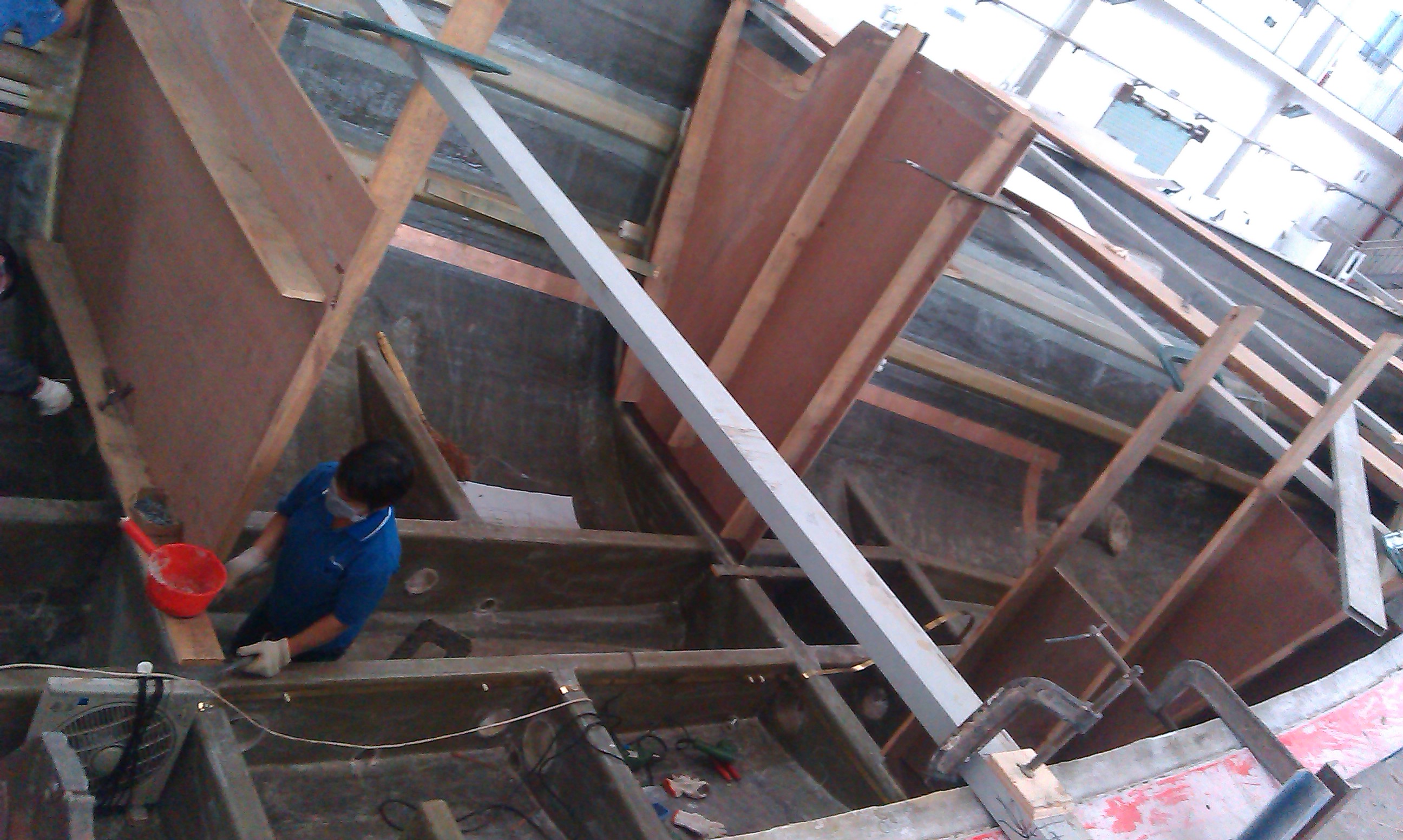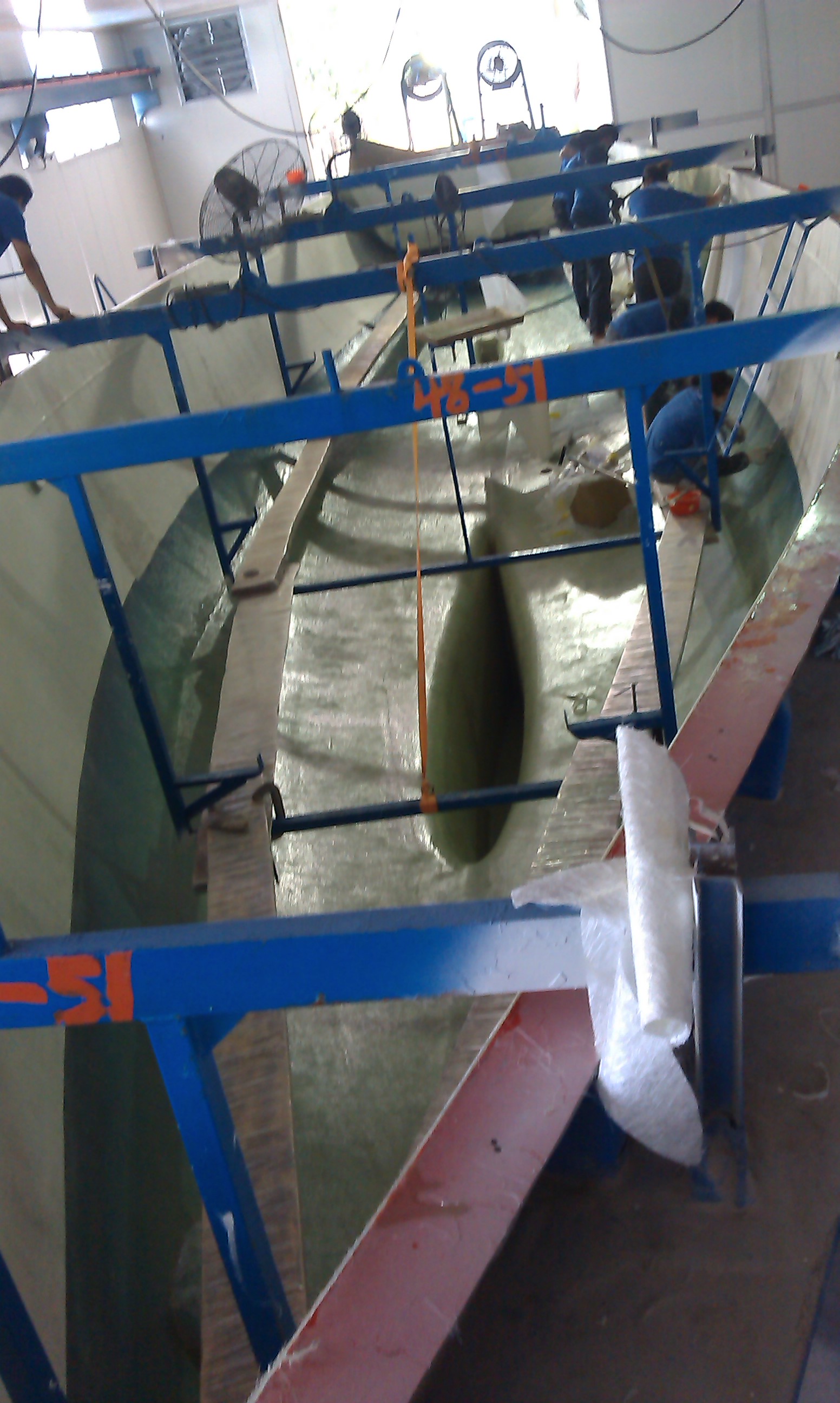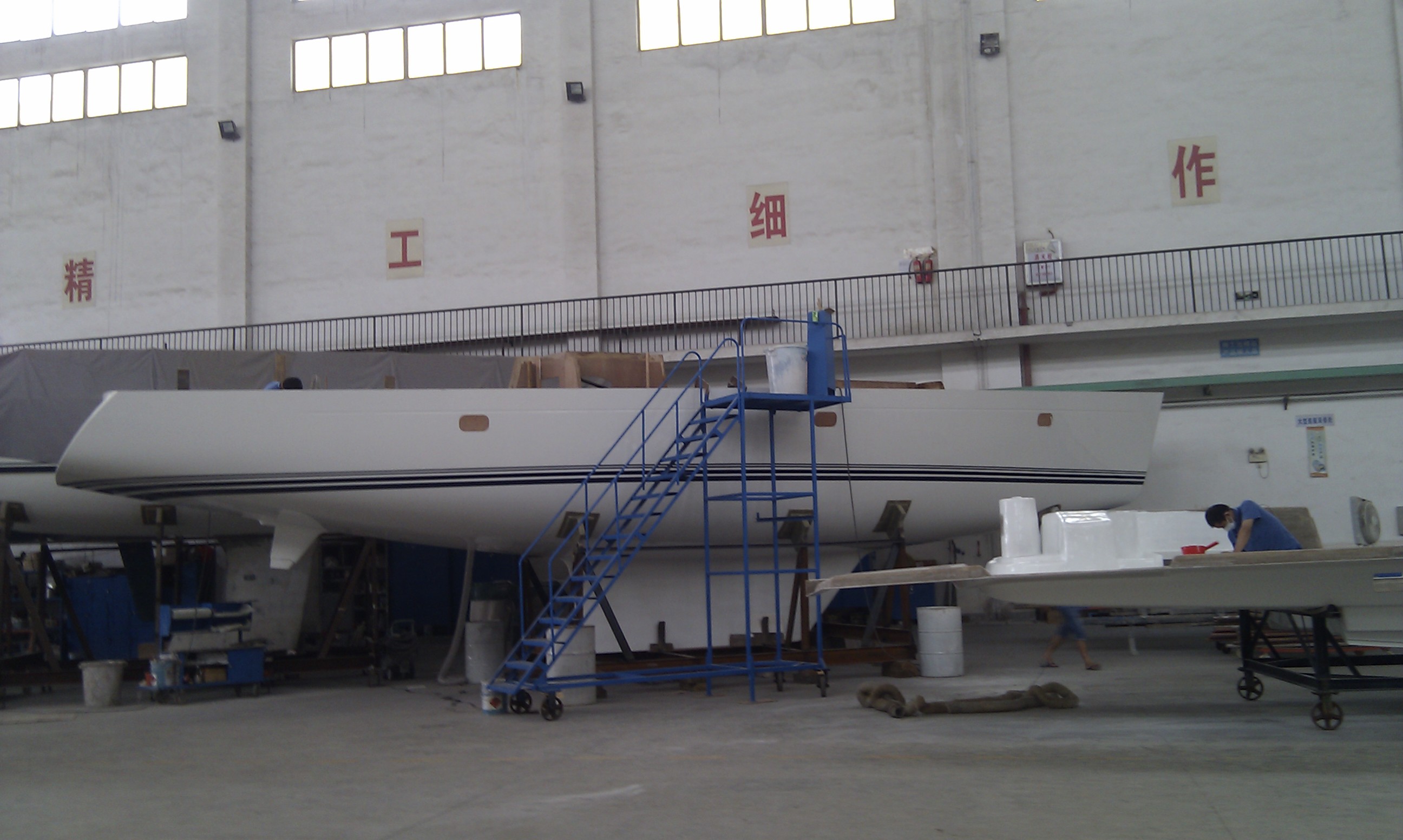When sailors talk about “true bluewater boats,” the conversation often turns to hull construction. It’s the one element that you can’t change once you’ve left the boatyard, and it�’s the foundation of everything else—rig, systems, comfort, and safety. While nearly any seaworthy sailboat can make a downwind tradewind passage like the Coconut Milk Run, the freedom to sail anywhere in the world—to the higher latitudes, into confused seas, or across thousands of miles of open ocean—demands a hull built to endure.
Strength. Integrity. Seakindly motion. These are the hallmarks of a voyaging hull. And Wanderlust, our 2014 Passport 545 Aft Cockpit, embodies them in every line of fiberglass and resin.
Solid Fiberglass and Aramid Reinforcement
Wanderlust’s hull is built of solid fiberglass, hand-laid with advanced stitched biaxial fabric. To further increase impact resistance and tensile strength, the laminate is reinforced with aramid fibers—materials more commonly associated with aerospace and ballistic applications. All of it is bonded with 100% vinyl ester resin, chosen for its superior resistance to osmotic blistering. Finished with Ashland Maxguard gelcoat, the result is a surface that retains both strength and beauty after years at sea.

Stiffness and Structural Integrity
A hull is more than its skin. Inside Wanderlust, longitudinal and transverse stringers are laminated with biaxial cloth and high-performance foam core. Bulkheads are tabbed directly to both the hull and deck, forming a single load-bearing structure. This is a key difference from many modern production boats, where interiors are often modular liners bonded into place rather than fully tabbed. The Passport approach results in greater rigidity and fewer stress points. Offshore, the difference is tangible: the boat feels quiet, solid, and confidence-inspiring when the seas build.
Watertight Bulkhead
Forward of the v-berth, Wanderlust incorporates a watertight bulkhead separating the forward cabin from the anchor locker. In the event of a collision or damage to the bow, this sealed barrier helps preserve hull integrity, preventing flooding from spreading into the living spaces. It’s a feature you rarely see on production cruising yachts, but one that reflects a true commitment to offshore safety.
Deck and Hull-to-Deck Joint
Above the waterline, Wanderlust’s deck is cored with closed-cell Divinycell foam, striking a balance between strength and weight. Every high-load area—winches, cleats, stanchions—is reinforced with high-density Divinycell H200, then through-bolted with stainless backing plates. The hull-to-deck joint, often a weak point in lesser boats, is engineered for redundancy: an outward-turning deck flange mates with an inward-turning hull flange, bonded, through-bolted, and encapsulated in fiberglass. The result is a watertight, structurally unified connection designed to withstand decades of offshore abuse.

Keel and Ballast
Where many modern boats rely on bolt-on keels, Wanderlust carries an integrally molded fin keel—one with no bolts to loosen or corrode. Inside it sits 14,700 pounds of encapsulated lead ballast, sealed in fiberglass. This low center of gravity provides a powerful righting moment and remarkable stability. When seas get steep, the keel keeps her on her feet; when storms threaten, it offers security and peace of mind. Encapsulation also eliminates common worries like leaking keel bolts or hidden corrosion, making Wanderlust a vessel designed for self-reliance far from any boatyard.
Rudder and Steering Confidence
A balanced, partial skeg-hung rudder completes the picture, supported by an internal stainless steel rudderpost and integral reinforcement. Compared to a spade rudder—a favorite of racing designs for its responsiveness—a skeg-hung rudder offers a compromise between performance and protection. The skeg shields the rudder from floating debris and cushions the impact of groundings, while still allowing for precise handling. Offshore, that extra measure of security matters.
Hull Form: Comfort Without Compromise
Performance offshore isn’t measured in fractions of a knot; it’s measured in comfort, predictability, and the ability to keep making miles day after day. Wanderlust’s hull strikes that balance. With a moderate displacement-to-length ratio, a fin keel, and a balanced hull shape, she is easily driven compared to the heavy, full-keel “tanks” of a generation ago. At the same time, her deeper hull sections avoid the flat-bottom pounding common to ultralight racing hulls. The result is a motion that is both seakindly and efficient—a boat that sails well yet doesn’t punish her crew.
As designer Bob Perry himself noted in describing the Passport Vista line, the hull form reflects deliberate choices: more freeboard to accommodate both aft- and center-cockpit layouts, a reduced bow overhang to extend the waterline, and firm bilges to provide early form stability. “I gave the new model, the Passport Vista, a long waterline, a broad stern, and plenty of firmness through the bilges to ensure form stability at early heel angles,” Perry wrote in his book, “Yacht Design According to Perry”. For voyagers, these details translate directly into performance, safety, and comfort at sea.
Deeper Bilges and Real-World Storage
One often-overlooked advantage of Wanderlust’s hull form is her deeper bilges. Modern flat-bottom designs may reduce wetted surface and add speed in light air, but they sacrifice something every voyager needs: stowage. The Passport’s hull shape not only contributes to her comfortable motion at sea, it also creates valuable volume below the cabin sole.
That extra space matters offshore. Fuel and water tanks, spares, and provisions can be stored low in the boat rather than stacked high in lockers. Keeping weight low improves stability and increases righting moment, making the boat more forgiving in heavy weather. It also enhances her seakindly motion: Wanderlust carries her weight deep, where it steadies the hull instead of amplifying roll. Offshore, this translates to a quieter, more predictable ride and the ability to carry the stores required for long, self-reliant passages.
Key Hull Construction Lessons for Cruisers
When sailors dream of their next boat, it’s easy to be seduced by sleek lines or glossy interiors. But for serious passagemaking, construction choices matter more than aesthetics. Wanderlust highlights some of the key lessons any cruiser should keep in mind:
- Keels: An encapsulated keel like Wanderlust’s adds weight low in the hull and avoids the bolt-on vulnerabilities of many production boats. Bolt-on keels perform well but require ongoing inspection of bolts and bedding to ensure long-term security.
- Rudders: A spade rudder, fully unsupported by a skeg, offers fingertip steering and is the standard for racing designs. The tradeoff is vulnerability: a hard grounding or collision with debris can disable the rudder completely. A partial skeg-hung rudder, while a little less responsive, strikes a balance between protection and control.
- Bulkheads: Many production yachts today (Beneteau, Jeanneau, Bavaria) use modular interior liners or partially bonded furniture to provide stiffness, which is faster and cheaper to build. Boats like Wanderlust, with bulkheads fully tabbed into hull and deck, create a true monocoque structure that resists flexing and distributes loads more effectively.
- Resin and laminates: Polyester resins are economical but prone to osmotic blistering. Vinyl ester and epoxy resins, paired with advanced fabrics like biaxial cloth and aramid reinforcement, provide far better resistance to water intrusion and structural fatigue.
Understanding these tradeoffs helps sailors separate marketing gloss from construction reality—and decide whether a boat is suited to a weekend coastal hop or a 3,000-mile ocean passage.
Built for the Long Haul
Hull construction isn’t just about performance offshore—it’s about how the boat ages. A well-built hull provides dividends in reduced maintenance, higher resale value, and greater confidence over decades of ownership.
- Osmosis resistance: Wanderlust’s vinyl ester laminate minimizes the risk of blisters, a problem that has plagued many production boats as they age.
- Joint integrity: A properly engineered hull-to-deck joint, glassed and through-bolted, means fewer leaks and far less structural movement over time. Lesser designs often reveal themselves with squeaks, flex, and hairline cracks after years of hard sailing.
- Encapsulated ballast: Without keel bolts to corrode, the risk of catastrophic failure decades down the line is eliminated. For a voyager far from a haul-out facility, that peace of mind is priceless.
- Stiffness: Wanderlust’s integrated bulkheads and structural stringers significantly reduce hull flexing, which can lead to long-term fatigue in both the structure and the interior joinery. On my previous boat, a 2005 Beneteau 423, I watched the gap between a bulkhead and the hull open and close as we crossed the Gulf Stream. That constant working may be acceptable in coastal cruising, but over years of passagemaking it takes a toll. Wanderlust’s construction, by contrast, feels monolithic and solid even in rough seas, protecting both the hull and the living space inside.
Ultimately, these choices aren’t about “showroom appeal”—they’re about making sure the boat you sail across oceans remains strong and seaworthy twenty or thirty years later. Wanderlust’s construction was designed with that horizon in mind.
Why It Matters
Hull construction isn’t a topic that inspires glossy marketing brochures or dockside daydreams. But when you’re hundreds of miles offshore, it becomes everything. It’s what separates a comfortable night watch from a white-knuckled struggle, and what turns long passages into the kind of voyaging Jane and I love: the freedom to go anywhere, safely and with confidence.
Wanderlust’s hull was designed and built with these demands in mind. It’s why she isn’t just a sailboat, but a true bluewater voyager.
